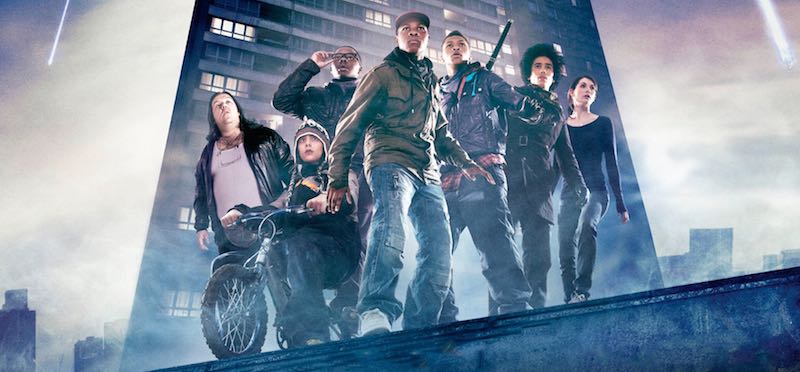 As soon as Steven Spielberg struck gold in 1975 with his blockbuster hit Jaws, seemingly every tiny studio in Hollywood scrambled to make a man vs. beast movie in an attempt to capitalize on the “animal horror” trend. First up to the plate, in 1976, was Grizzly, a film that (like the name suggests) features a killer bear in the antagonist role. Grizzly was quickly directed by William Girdler (who would go on to make Day of the Animals and The Manitou) on a shoestring budget, and it became an instant cult classic.
As soon as Steven Spielberg struck gold in 1975 with his blockbuster hit Jaws, seemingly every tiny studio in Hollywood scrambled to make a man vs. beast movie in an attempt to capitalize on the “animal horror” trend. First up to the plate, in 1976, was Grizzly, a film that (like the name suggests) features a killer bear in the antagonist role. Grizzly was quickly directed by William Girdler (who would go on to make Day of the Animals and The Manitou) on a shoestring budget, and it became an instant cult classic.
 Grizzly stars Christopher George (Sergeant Sam Troy from T.V.’s “The Rat Patrol”) as Forest Ranger Michael Kelly. While on a routine patrol of his park, Kelly finds a pair of mutilated women who have obviously been victims of an animal attack. Once the doctors determine that the culprit was a giant grizzly bear, Kelly tries to close the park until the bear can be caught. The Park Supervisor Charlie Kittridge (Joe Dorsey from WarGames and Brainstorm) argues with Kelly, opting instead to move the vacationing guests to a different area and keep the park open.
Grizzly stars Christopher George (Sergeant Sam Troy from T.V.’s “The Rat Patrol”) as Forest Ranger Michael Kelly. While on a routine patrol of his park, Kelly finds a pair of mutilated women who have obviously been victims of an animal attack. Once the doctors determine that the culprit was a giant grizzly bear, Kelly tries to close the park until the bear can be caught. The Park Supervisor Charlie Kittridge (Joe Dorsey from WarGames and Brainstorm) argues with Kelly, opting instead to move the vacationing guests to a different area and keep the park open.
When the bear keeps killing, Kittridge fills the woods with local hunters by putting a bounty out on the bear. Not only does Kelly have a ferocious rogue bear to deal with, but he’s also got a forest full of drunken idiots to worry about. The rational Kelly decides to team up with a zoologist and a helicopter pilot (played by veteran T.V. character actors Richard Jaeckel and Andrew Prine, respectively) to track, hunt and kill the bear themselves. Once the three men find the bear, they learn that their enemy is an 18-foot prehistoric grizzly that lives to kill, and they are standing right in its way.
 Grizzly is a formula rip-off of Jaws. From the stubborn park director to the trio of hunters, every element of Jaws can be found in the film. All that screenwriters Harvey Flaxman and David Sheldon have done are replace the ocean with a forest, substitute a bear for the shark and trade in the boat for a helicopter.
Grizzly is a formula rip-off of Jaws. From the stubborn park director to the trio of hunters, every element of Jaws can be found in the film. All that screenwriters Harvey Flaxman and David Sheldon have done are replace the ocean with a forest, substitute a bear for the shark and trade in the boat for a helicopter.
Most of the major plot points and conflicts are the same. The main difference between the two films is in the characters. Unlike the main characters in Jaws, the characters in Grizzly are written with no depth, and the actors are not skilled enough to elicit an emotional response from the audience. The result is a bunch of people onscreen that the viewer does not care about.
So why is Grizzly such a great movie? Grizzly succeeds because of these character shortcomings, not in spite of them.
 Grizzly is a fun movie for one reason – the grizzly. Because the people in the movie are so shallow and two-dimensional, the audience finds itself rooting for the bear. Nothing is more satisfying than seeing an annoying character meet a brutal death, and Grizzly boasts some of the bloodiest kills ever committed to celluloid.
Grizzly is a fun movie for one reason – the grizzly. Because the people in the movie are so shallow and two-dimensional, the audience finds itself rooting for the bear. Nothing is more satisfying than seeing an annoying character meet a brutal death, and Grizzly boasts some of the bloodiest kills ever committed to celluloid.
Plus, with the exception of a fake arm or claw, the filmmakers use a real bear to portray the killer beast. The bear kill scenes are just plain cool, and not simply because of the carnage. The bear knocks down cabins and ranger stations to get to its prey. The level of determination of the bear is the same as the level of determination of the shark in Jaws, and both are powerful and formidable foes.
Grizzly was a box office success, opening the door for several more Jaws clones to be made in the few years following its release. The existence of films like Orca, Tentacles, Alligator, and Piranha can all be credited to, or blamed on, the original rip-off that is Grizzly.
